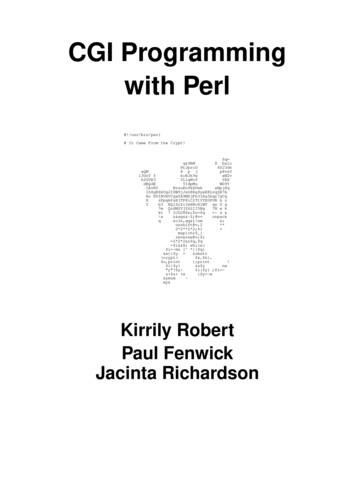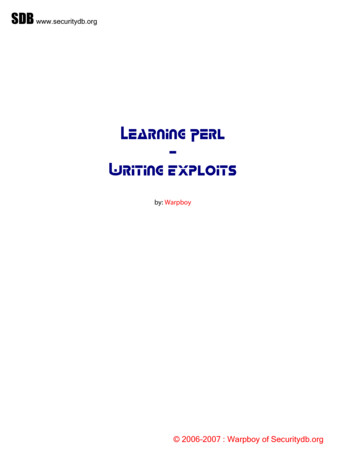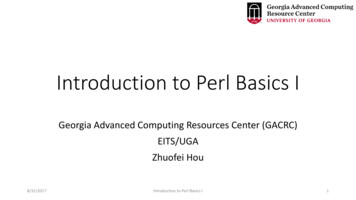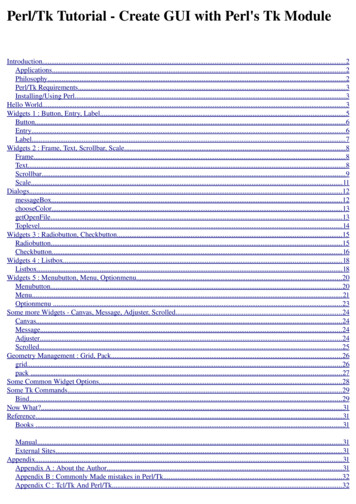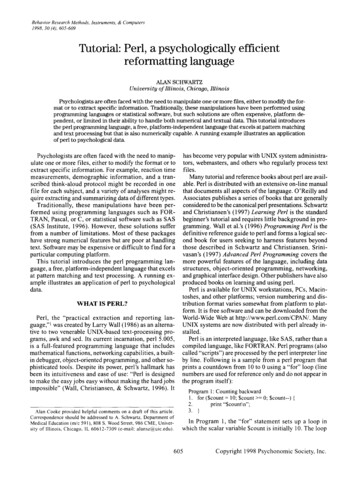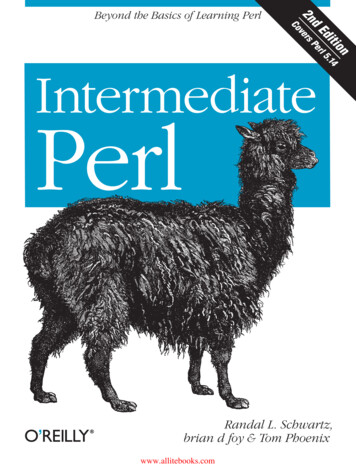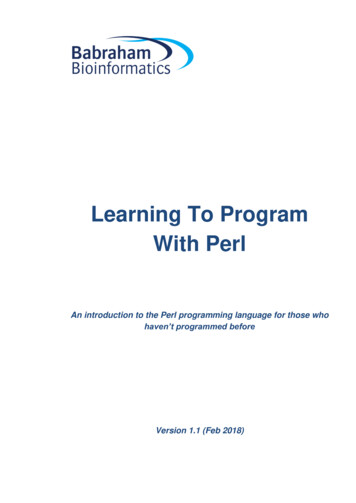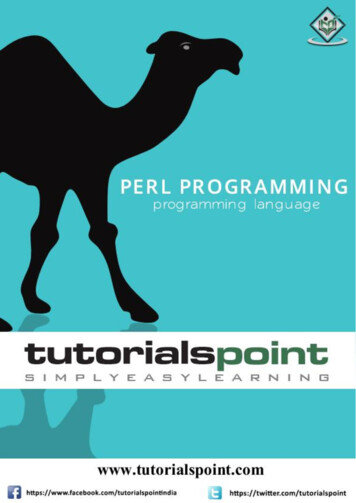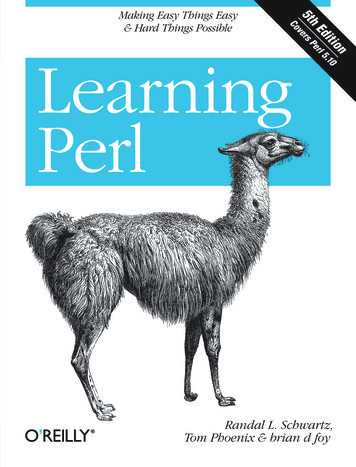
Transcription
Learning Perl
Other Perl resources from O’ReillyRelated titlesPerl BooksResource CenterAdvanced Perl ProgrammingIntermediate PerlMastering PerlPerl 6 and Parrot EssentialsPerl Best PracticesPerl Cookbook Perl Debugger PocketReferencePerl in a NutshellPerl Testing: A Developer’sNotebook Practical mod-perlperl.oreilly.com is a complete catalog of O’Reilly’s books on Perland related technologies, including sample chapters and codeexamples.Perl.com is the central web site for the Perl community. It is theperfect starting place for finding out everything there is to knowabout Perl.ConferencesO’Reilly brings diverse innovators together to nurture the ideasthat spark revolutionary industries. We specialize in documenting the latest tools and systems, translating the innovator’sknowledge into useful skills for those in the trenches. Visitconferences.oreilly.com for our upcoming events.Safari Bookshelf (safari.oreilly.com) is the premier online reference library for programmers and IT professionals. Conductsearches across more than 1,000 books. Subscribers can zero inon answers to time-critical questions in a matter of seconds.Read the books on your Bookshelf from cover to cover or simply flip to the page you need. Try it today with a free trial.
FIFTH EDITIONTomcatLearningPerlThe Definitive GuideJasonBrittainandandIanbrianF. DarwinRandal L. Schwartz,TomPhoenix,d foyBeijing Cambridge Farnham Köln Sebastopol Taipei Tokyo
Learning Perl, Fifth Editionby Randal L. Schwartz, Tom Phoenix, and brian d foyCopyright 2008 O’Reilly Media. All rights reserved.Printed in the United States of America.Published by O’Reilly Media, Inc., 1005 Gravenstein Highway North, Sebastopol, CA 95472.O’Reilly books may be purchased for educational, business, or sales promotional use. Online editionsare also available for most titles (http://safari.oreilly.com). For more information, contact our corporate/institutional sales department: (800) 998-9938 or corporate@oreilly.com.Editor: Andy OramProduction Editor: Loranah DimantCopyeditor: Loranah DimantProofreader: Sada PreischIndexer: Ellen Troutman ZaigCover Designer: Karen MontgomeryInterior Designer: David FutatoIllustrator: Jessamyn ReadPrinting History:November 1993:July 1997:July 2001:July 2005:July 2008:First Edition.Second Edition.Third Edition.Fourth Edition.Fifth Edition.Nutshell Handbook, the Nutshell Handbook logo, and the O’Reilly logo are registered trademarks ofO’Reilly Media, Inc. Learning Perl, the image of a llama, and related trade dress are trademarks ofO’Reilly Media, Inc.Many of the designations used by manufacturers and sellers to distinguish their products are claimed astrademarks. Where those designations appear in this book, and O’Reilly Media, Inc. was aware of atrademark claim, the designations have been printed in caps or initial caps.While every precaution has been taken in the preparation of this book, the publisher and authors assumeno responsibility for errors or omissions, or for damages resulting from the use of the information contained herein.ISBN: 978-0-596-52010-6[M]1213729146
Table of ContentsPreface . . . . . . . . . . . . . . . . . . . . . . . . . . . . . . . . . . . . . . . . . . . . . . . . . . . . . . . . . . . . . . . . . . . . . xi1.Introduction . . . . . . . . . . . . . . . . . . . . . . . . . . . . . . . . . . . . . . . . . . . . . . . . . . . . . . . . . . . . 1Questions and AnswersWhat Does “Perl” Stand For?How Can I Get Perl?How Do I Make a Perl Program?A Whirlwind Tour of PerlExercises2.Scalar Data . . . . . . . . . . . . . . . . . . . . . . . . . . . . . . . . . . . . . . . . . . . . . . . . . . . . . . . . . . . . 19NumbersStringsPerl’s Built-in WarningsScalar VariablesOutput with printThe if Control StructureGetting User InputThe chomp OperatorThe while Control StructureThe undef ValueThe defined 38Lists and Arrays . . . . . . . . . . . . . . . . . . . . . . . . . . . . . . . . . . . . . . . . . . . . . . . . . . . . . . . . 39Accessing Elements of an ArraySpecial Array IndicesList LiteralsList AssignmentInterpolating Arrays into StringsThe foreach Control StructureScalar and List Context40414143464749v
STDIN in List ContextExercises4.Subroutines . . . . . . . . . . . . . . . . . . . . . . . . . . . . . . . . . . . . . . . . . . . . . . . . . . . . . . . . . . . 55Defining a SubroutineInvoking a SubroutineReturn ValuesArgumentsPrivate Variables in SubroutinesVariable-Length Parameter ListsNotes on Lexical (my) VariablesThe use strict PragmaThe return OperatorNonscalar Return ValuesPersistent, Private VariablesExercises5.717375767981838688909091Hashes . . . . . . . . . . . . . . . . . . . . . . . . . . . . . . . . . . . . . . . . . . . . . . . . . . . . . . . . . . . . . . . . 93What Is a Hash?Hash Element AccessHash FunctionsTypical Use of a HashThe %ENV hashExercises7.555656586060636465676869Input and Output . . . . . . . . . . . . . . . . . . . . . . . . . . . . . . . . . . . . . . . . . . . . . . . . . . . . . . . 71Input from Standard InputInput from the Diamond OperatorThe Invocation ArgumentsOutput to Standard OutputFormatted Output with printfFilehandlesOpening a FilehandleFatal Errors with dieUsing FilehandlesReopening a Standard FilehandleOutput with sayExercises6.52549396100103104105In the World of Regular Expressions . . . . . . . . . . . . . . . . . . . . . . . . . . . . . . . . . . . . . . 107What Are Regular Expressions?Using Simple PatternsCharacter Classesvi Table of Contents107108113
Exercises8.Matching with Regular Expressions . . . . . . . . . . . . . . . . . . . . . . . . . . . . . . . . . . . . . . . 117Matches with m//Option ModifiersAnchorsThe Binding Operator, Interpolating into PatternsThe Match VariablesGeneral QuantifiersPrecedenceA Pattern Test 2Processing Text with Regular Expressions . . . . . . . . . . . . . . . . . . . . . . . . . . . . . . . . . 135Substitutions with s///The split OperatorThe join Functionm// in List ContextMore Powerful Regular ExpressionsExercises13513813914014014710. More Control Structures . . . . . . . . . . . . . . . . . . . . . . . . . . . . . . . . . . . . . . . . . . . . . . . . 149The unless Control StructureThe until Control StructureExpression ModifiersThe Naked Block Control StructureThe elsif ClauseAutoincrement and AutodecrementThe for Control StructureLoop ControlsThe Ternary Operator, ?:Logical 811. Perl Modules . . . . . . . . . . . . . . . . . . . . . . . . . . . . . . . . . . . . . . . . . . . . . . . . . . . . . . . . . . 169Finding ModulesInstalling ModulesUsing Simple ModulesExercise16917017117712. File Tests . . . . . . . . . . . . . . . . . . . . . . . . . . . . . . . . . . . . . . . . . . . . . . . . . . . . . . . . . . . . . 179File Test Operators179Table of Contents vii
The stat and lstat FunctionsThe localtime FunctionBitwise OperatorsExercises18618718818913. Directory Operations . . . . . . . . . . . . . . . . . . . . . . . . . . . . . . . . . . . . . . . . . . . . . . . . . . . 191Moving Around the Directory TreeGlobbingAn Alternate Syntax for GlobbingDirectory HandlesRecursive Directory ListingManipulating Files and DirectoriesRemoving FilesRenaming FilesLinks and FilesMaking and Removing DirectoriesModifying PermissionsChanging OwnershipChanging 0520520620614. Strings and Sorting . . . . . . . . . . . . . . . . . . . . . . . . . . . . . . . . . . . . . . . . . . . . . . . . . . . . 209Finding a Substring with indexManipulating a Substring with substrFormatting Data with sprintfAdvanced SortingExercises20921021221421915. Smart Matching and given-when . . . . . . . . . . . . . . . . . . . . . . . . . . . . . . . . . . . . . . . . 221The Smart Match OperatorSmart Match PrecedenceThe given Statementwhen with Many ItemsExercises22122422522923016. Process Management . . . . . . . . . . . . . . . . . . . . . . . . . . . . . . . . . . . . . . . . . . . . . . . . . . 233The system FunctionThe exec FunctionThe Environment VariablesUsing Backquotes to Capture OutputProcesses as FilehandlesGetting Down and Dirty with ForkSending and Receiving Signalsviii Table of Contents233236237238241243244
Exercises24617. Some Advanced Perl Techniques . . . . . . . . . . . . . . . . . . . . . . . . . . . . . . . . . . . . . . . . . 249Trapping Errors with evalPicking Items from a List with grepTransforming Items from a List with mapUnquoted Hash KeysSlicesExercise249252253254254259A.Exercise Answers . . . . . . . . . . . . . . . . . . . . . . . . . . . . . . . . . . . . . . . . . . . . . . . . . . . . . . 261B.Beyond the Llama . . . . . . . . . . . . . . . . . . . . . . . . . . . . . . . . . . . . . . . . . . . . . . . . . . . . . 295Index . . . . . . . . . . . . . . . . . . . . . . . . . . . . . . . . . . . . . . . . . . . . . . . . . . . . . . . . . . . . . . . . . . . . . 315Table of Contents ix
PrefaceWelcome to the fifth edition of Learning Perl, updated for Perl 5.10 and its latest features. This book is good even if you are still using Perl 5.6 (although, it’s been a longtime since it was released; have you thought about upgrading?).If you’re looking for the best way to spend your first 30 to 45 hours with the Perlprogramming language, you’ve found it. In the pages that follow, you’ll find a carefullypaced introduction to the language that is the workhorse of the Internet, as well as thelanguage of choice for system administrators, web hackers, and casual programmersaround the world.We can’t give you all of Perl in just a few hours. The books that promise that areprobably fibbing a bit. Instead, we’ve carefully selected a useful subset of Perl for youto learn, good for programs from 1 to 128 lines long, which end up being about 90%of the programs in use out there. And when you’re ready to go on, you can get Intermediate Perl, which picks up where this book leaves off. We’ve also included a numberof pointers for further education.Each chapter is small enough so you can read it in an hour or two. Each chapter endswith a series of exercises to help you practice what you’ve just learned, with the answersin Appendix A for your reference. Thus, this book is ideally suited for a classroom“Introduction to Perl” course. We know this directly because the material for this bookwas lifted almost word-for-word from our flagship “Learning Perl” course, deliveredto thousands of students around the world. However, we’ve designed the book for selfstudy as well.Perl lives as the “toolbox for Unix,” but you don’t have to be a Unix guru—or even aUnix user—to read this book. Unless otherwise noted, everything we’re saying appliesequally well to Windows ActivePerl from ActiveState and pretty much every othermodern implementation of Perl.Although you don’t need to know a single bit about Perl to begin reading this book,we recommend that you already have familiarity with basic programming conceptssuch as variables, loops, subroutines, and arrays, and the all-important “editing asource code file with your favorite text editor.” We don’t spend any time trying toexplain those concepts. Although we’re pleased that we’ve had many reports of peoplexi
picking up Learning Perl and successfully grasping Perl as their first programming language, of course, we can’t promise the same results for everyone.Typographical ConventionsThe following font conventions are used in this book:Constant widthUsed for method names, function names, variables, and attributes. It is also usedfor code examples.Constant width boldUsed to indicate user input.Constant width italicUsed to indicate a replaceable item in code (e.g., filename, where you are supposedto substitute an actual filename).ItalicUsed for filenames, URLs, hostnames, commands in text, important words on firstmention, and emphasis.FootnotesUsed to attach parenthetical notes that you should not read on your first (or perhapssecond or third) reading of this book. Sometimes lies are spoken to simplify thepresentation, and the footnotes restore the lie to truth. Often, the material in thefootnote will be advanced material not even discussed anywhere else in the book.How to Contact UsWe have tested and verified all the information in this book to the best of our abilities,but you may find that features have changed or that we have let errors slip through theproduction of the book. Please let us know of any errors that you find, as well as suggestions for future editions, by writing to:O’Reilly Media, Inc.1005 Gravenstein Highway NorthSebastopol, CA 95472800-998-9938 (in the U.S. or Canada)707-829-7000 (international/local)707-829-0104 (fax)You can also send messages electronically. To be put on our mailing list or to requesta catalog, send email to:info@oreilly.comxii Preface
To ask technical questions or to comment on the book, send email to:bookquestions@oreilly.comWe have a web site for the book, where we’ll list examples, errata, and any plans forfuture editions. It also offers a downloadable set of text files (and a couple of Perlprograms) that are useful, but not required, when doing some of the exercises. You canaccess this page at:http://www.oreilly.com/catalog/9780596520106For more information about this book and others, see the O’Reilly web site:http://www.oreilly.comUsing Code ExamplesThis book is here to help you get your job done. In general, you may use the code inthis book in your programs and documentation. You do not need to contact us forpermission unless you’re reproducing a significant portion of the code. For example,writing a program that uses several chunks of code from this book does not requirepermission. Selling or distributing a CD-ROM of examples from O’Reilly books doesrequire permission. Answering a question by citing this book and quoting examplecode does not require permission. Incorporating a significant amount of example codefrom this book into your product’s documentation does require permission. We appreciate, but do not require, attribution. An attribution usually includes the title, author, publisher, and ISBN. For example: “Learning Perl, Fifth edition, by Randal L.Schwartz, Tom Phoenix, and brian d foy. Copyright 2008 O’Reilly Media, Inc.,978-0-596-52010-6.” If you feel your use of code examples falls outside fair use or thepermission given above, feel free to contact us at permissions@oreilly.com.Safari EnabledWhen you see a Safari Enabled icon on the cover of your favorite technology book, that means the book is available online through the O’ReillyNetwork Safari Bookshelf.Safari offers a solution that’s better than e-books. It’s a virtual library that lets you easilysearch thousands of top tech books, cut and paste code samples, download chapters,and find quick answers when you need the most accurate, current information. Try itfor free at http://safari.oreilly.com.Preface xiii
History of This BookFor the curious, here’s how Randal tells the story of how this book came about:After I had finished the first Programming Perl book with Larry Wall (in 1991), I wasapproached by Taos Mountain Software in Silicon Valley to produce a training course.This included having me deliver the first dozen or so courses and train their staff tocontinue offering the course. I wrote the course for them* and delivered it as promised.On the third or fourth delivery of that course (in late 1991), someone came up to meand said, “You know, I really like Programming Perl, but the way the material is presented in this course is so much easier to follow—you oughta write a book like thiscourse.” It sounded like an opportunity to me, so I started thinking about it.I wrote to Tim O’Reilly with a proposal based on an outline that was similar to thecourse I was presenting for Taos—although I had rearranged and modified a few of thechapters based on observations in the classroom. I think that was my fastest proposalacceptance in history—I got a message from Tim within 15 minutes saying, “We’vebeen waiting for you to pitch a second book—Programming Perl is selling like gangbusters.” That started the effort over the next 18 months to finish the first edition ofLearning Perl.During that time, I was starting to see an opportunity to teach Perl classes outsideSilicon Valley,† so I created a class based on the text I was writing for Learning Perl. Igave a dozen classes for various clients (including my primary contractor, Intel Oregon),and used the feedback to fine-tune the book draft even further.The first edition hit the streets on the first day of November 1993‡ and became asmashing success, frequently even outpacing Programming Perl book sales.The back-cover jacket of the first book said “written by a leading Perl trainer.” Well,that became a self-fulfilling prophesy. Within a few months, I was starting to get emailfrom people all over the United States asking me to teach at their site. In the followingseven years, my company became the leading worldwide on-site Perl training company,and I had personally racked up (literally) a million frequent-flier miles. It didn’t hurtthat the Web started taking off about then, and the webmasters and webmistressespicked Perl as the language of choice for content management, interaction throughCGI, and maintenance.* In the contract, I retained the rights to the exercises, hoping someday to reuse them in some other way, likein the magazine columns I was writing at the time. The exercises are the only things that leapt from the Taoscourse to the book.† My Taos contract had a no-compete clause, so I had to stay out of Silicon Valley with any similar courses,which I respected for many years.‡ I remember that date very well because it was also the day I was arrested at my home for computer-related-activities around my Intel contract, a series of felony charges for which I was later convicted.xiv Preface
For two years, I worked closely with Tom Phoenix in his role as lead trainer and contentmanager for Stonehenge, giving him charter to experiment with the “Llama” course bymoving things around and breaking things up. When we had come up with what wethought was the best major revision of the course, I contacted O’Reilly and said, “It’stime for a new book!” And that became the third edition.Two years after writing the third edition of the Llama, Tom and I decided it was timeto push our follow-on “advanced” course out into the world as a book, for peoplewriting programs that are “100 to 10,000 lines of code.” And together we created thefirst Alpaca book, released in 2003.But fellow instructor brian d foy was just getting back from the conflict in the Gulf, andhad noticed that we could use some rewriting in both books because our coursewarestill needed to track the changing needs of the typical student. So, he pitched the ideato O’Reilly to take on rewriting both the Llama and the Alpaca one final time beforePerl 6 (we hope). This fifth edition of the Llama reflects those changes. brian was reallythe lead writer, working with my occasional guidance, and has done a brilliant job ofthe usual “herding cats” that a multiple-writer team generally feels like.On December 18, 2007, the perl5porters released Perl 5.10, a significant new versionof Perl with several new features. The previous version, 5.8, had focused on theunderpinnings of Perl and its Unicode support. The latest version, starting from thestable 5.8 foundation, was able to add completely new features, some of which it borrowed from the development of Perl 6 (not yet released). Some of these features, suchas named captures in regular expressions, are much better than the old ways of doingthings, thus perfect for Perl beginners. We hadn’t thought about a fifth edition of thisbook, but Perl 5.10 was so much better that we couldn’t resist.Some of the differences you may notice from prior editions: The text is updated for the latest version, Perl 5.10, and some of the code onlyworks with that version. We note in the text when we are talking about a Perl 5.10feature, and we mark those code sections with a special use statement that ensuresyou’re using the right version:use 5.010; # this script requires Perl 5.10 or greaterIf you don’t see that use 5.010 in a code example, it should work all the way backto Perl 5.6. To see which version of Perl you have, try the -v command-line switch:prompt% perl -vHere are some of the new features from Perl 5.10 that we cover, and where appropriate,we still show you the old ways of doing the same thing: There is more information in the regular expression chapters, covering the newfeatures from Perl 5.10. These include relative back references (Chapter 7), newcharacter classes (Chapter 7), and named captures (Chapter 8).Preface xv
Perl 5.10 includes a switch statement, which it calls given-when. We cover it inChapter 15 along with the smart match operator. Subroutines now have static variables just like C does, although Perl calls themstate variables. They persist between calls to the subroutine and are lexicallyscoped. We cover that in Chapter 4.AcknowledgmentsFrom Randal. I want to thank the Stonehenge trainers past and present (Joseph Hall,Tom Phoenix, Chip Salzenberg, brian d foy, and Tad McClellan) for their willingnessto go out and teach in front of classrooms week after week and to come back with theirnotes about what’s working (and what’s not), so we could fine-tune the material forthis book. I especially want to single out my coauthor and business associate, TomPhoenix, for having spent many, many hours working to improve Stonehenge’s Llamacourse and to provide the wonderful core text for most of this book. And brian d foyfor being the lead writer of the fourth edition, including taking that eternal to-do itemout of my inbox so that it would finally happen.I also want to thank everyone at O’Reilly, especially our very patient editor and overseeron the previous edition, Allison Randal (no relation, but she has a nicely spelled lastname), and Tim O’Reilly himself for taking a chance on me in the first place with theCamel and Llama books.I am also absolutely indebted to the thousands of people who have purchased the pasteditions of the Llama so that I could use the money to stay “off the streets and out ofjail,” and to those students in my classrooms who have trained me to be a better trainer,and to the stunning array of Fortune 1000 clients who have purchased our classes inthe past and will continue to do so into the future.As always, a special thanks to Lyle and Jack, for teaching me nearly everything I knowabout writing. I won’t ever forget you guys.From Tom. I’ve got to echo Randal’s thanks to everyone at O’Reilly. For the thirdedition of this book, Linda Mui was our editor, and I still thank her, for her patiencein pointing out which jokes and footnotes were most excessive (she is in no way toblame for the ones that remain). Both she and Randal have guided me through thewriting process, and I am grateful. On the fourth edition, Allison Randal stepped in aseditor, and my thanks go to her as well.I also echo Randal with regard to the other Stonehenge trainers, who hardly ever complained when I unexpectedly updated the course materials to try out a new teachingtechnique. You folks have contributed many different viewpoints on teaching methodsthat I would never have seen.xvi Preface
For many years, I worked at the Oregon Museum of Science and Industry (OMSI), andI’d like to thank the folks there for letting me hone my teaching skills as I learned tobuild a joke or two into every activity, explosion, or dissection.To the many folks on Usenet who have given me your appreciation and encouragementfor my contributions there, thanks. As always, I hope this helps.Also to my many students, who have shown me with their questions (and befuddledlooks) when I needed to try a new way of expressing a concept. I hope that the presentedition helps to relieve any remaining puzzlement.Of course, deep thanks are due especially to my coauthor Randal for giving me thefreedom to try various ways of presenting the material both in the classroom and herein the book, as well as for the push to make this material into a book in the first place.And without fail, I must say that I am indeed inspired by your ongoing work to ensurethat no one else becomes ensnared by the legal troubles that have stolen so much ofyour time and energy; you’re a fine example.To my wife, Jenna, thanks for being a cat person, and everything thereafter.From brian. I have to thank Randal first, since I learned Perl from the first edition ofthis book, and then had to learn it again when he asked me to start teaching for Stonehenge in 1998. Teaching is often the best way to learn. Since then Randal has mentoredme not only in Perl, but in several other things he thought I needed to learn, like thetime he decided that we could use Smalltalk instead of Perl for a demonstration at aweb conference. I’m always amazed at the breadth of his knowledge. He’s the one whotold me to start writing about Perl. Now I’m helping out on the book where I started.I’m honored, Randal.I’ve probably only actually seen Tom Phoenix for less than two weeks in the entire timeI’ve worked for Stonehenge, but I’ve been teaching his version of our Learning Perlcourse for years. That version turned into the third edition of this book. Teaching Tom’snew version, I found new ways to explain almost everything, and learned even morecorners of Perl.When I convinced Randal that I should help out on the Llama update, I was anointedas the maker of the proposal to the publisher, the keeper of the outline, and the versioncontrol wrangler. Our editor on the fourth edition, Allison Randal, helped me get setup in all of those roles and endured my frequent emails without complaining.Special non-Perl thanks to Stacey, Buster, Mimi, Roscoe, Amelia, Lila, and everyoneelse who tried to distract me while I was busy but still talked to me even though Icouldn’t come out to play.From All of Us. Thanks to our reviewers David H. Adler, Andy Armstrong, Dave Cross,Chris Devers, Paul Fenwick, Stephen B. Jenkins, Matthew Musgrove, Steve Peters, andWil Wheaton for providing comments on the draft of this book.Preface xvii
Thanks also to our many students who have let us know what parts of the coursematerial have needed improvement over the years. It’s because of you that we’re all soproud of it today.Thanks to the many Perl Mongers who have made us feel at home as we’ve visited yourcities. Let’s do it again sometime.And finally, our sincerest thanks to our friend Larry Wall, for having the wisdom toshare his really cool and powerful toys with the rest of the world so that we can all getour work done just a little bit faster, easier, and with more fun.xviii Preface
CHAPTER 1IntroductionWelcome to the Llama book!This is the fifth edition of a book that has been enjoyed by half a million readers since1993. At least, we hope they’ve enjoyed it. It’s a sure thing that we’ve enjoyed writingit.*Questions and AnswersYou probably have some questions about Perl, and maybe even some about this book,especially if you’ve already flipped through it to see what’s coming. So, we’ll use thischapter to answer them.Is This the Right Book for You?If you’re anything like us, you’re probably standing in a bookstore right now,† wondering whether you should get this Llama book and learn Perl, or maybe that book overthere and learn some language named after a snake, or a beverage, or a letter of thealphabet.‡ You’ve got about two minutes before the bookstore manager comes over totell you that this isn’t a library,‖ and you need to buy something or get out. Maybe youwant to use these two minutes to see a quick Perl program, so you’ll know something* To be sure, the first edition was written by Randal L. Schwartz, the second by Randal and Tom Christiansen,then one by Randal and Tom Phoenix, and now by Randal, Tom Phoenix, and brian d foy. So, whenever wesay “we” in this edition, we mean that last group. Now, if you’re wondering how we can say that we’veenjoyed writing it (in the past tense) when we’re still on the first page, that’s easy: we started at the end, andworked our way backward. It sounds like a strange way to do it, we know. But, honestly, once we finishedwriting the index, the rest was hardly any trouble at all.† Actually, if you’re like us, you’re standing in a library, not a bookstore. But we’re tightwads.‡ Before you write to tell us that it’s a comedy troupe, not a snake, we should really explain that we’redyslexically thinking of CORBA.‖ Unless it is.1
about how powerful Perl is and what it can do. In that case, you should check out “AWhirlwind Tour of Perl,” later in this chapter.Why Are There So Many Footnotes?Thank you for noticing. There are a lot of footnotes in this book. Ignore them. They’reneeded because Perl is chock-full of exceptions to its rules. This is a good thing, as reallife is chock-full of exceptions to rules.But it means that we can’t honestly say, “The fizzbin operator frobnicates the hoozistatic variables” without a footnote giving the exceptions.* We’re pretty honest, so wehave to write the footnotes. But you can be honest without reading them. (It’s funnyhow that works out.)Many of the exceptions have to do with portability. Perl began on Unix systems, andit still has deep roots in Unix. But wherever possible, we’ve tried to show when something may behave unexpectedly, whether that’s because it’s running on a non-Unixsystem, or for another reason. We hope that readers who know nothing about Unixwill nevertheless find this book a good introduction to Perl. (And they’ll learn a littleabout Unix along the way, at no extra charge.)And many of the other exceptions have to do with the old “80/20” rule. By that wemean that 80% of th
Welcome to the fifth edition of Learning Perl, updated for Perl 5.10 and its latest fea-tures. This book is good even if you are still using Perl 5.6 (although, it's been a long time since it was released; have you thought about upgrading?). If you're looking for the best way to spend your first 30 to 45 hours with the Perl
